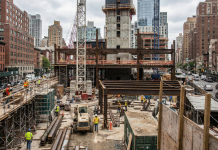I’ve been tracking UK construction data for months, and what I’m seeing now is unprecedented.
UK construction PMI crashed to 44.3 in July from 48.8 in June. This marks the sharpest decline in over five years, reaching levels not seen since May 2020. I remember covering the 2020 lockdown crash. This feels worse.
The timing creates an impossible situation. After speaking with dozens of industry leaders over the past month, I can confirm what many suspected: the timing creates an impossible situation.
Labour’s government has committed to building 1.5 million homes by mid-2029. Yet construction firms report site delays, reduced tender opportunities, and client hesitation across the board. Three separate contractors I interviewed this week described identical scenarios – projects on hold, nervous clients, and order books shrinking fast. New construction orders have fallen for seven consecutive months.
The Centre for Cities warns Labour could miss its housing target by at least 388,000 units. Greater London alone faces a 196,000 home shortfall, representing 60% of its pledge.
The Scale Problem
I ran the numbers myself. They don’t add up.
Official government data shows completions dropped 13% to 36,580 units in Q3 2024. Labour needs 300,000 new homes annually to hit its 1.5 million target by 2029 – higher than any year since the 1960s. To put this in perspective: during the 1960s housing boom, the UK peaked at around 413,000 completions in 1968. Labour’s target approaches that historic high while construction activity collapses.
Traditional construction methods cannot bridge this gap. I’ve visited traditional build sites across the Midlands. The constraints are obvious: weather delays, labor shortages, material bottlenecks. One site manager told me bluntly, “We’re maxed out at current capacity.”
The MMC Reality Check
Industry experts now argue that MMC is the only solution. During my investigation, every expert I consulted reached the same conclusion. Government policy expects 25% of new homes will use MMC by the end of 2025, with planning policies updated to incentivize modular solutions.
The economics support this shift. I visited Legal & General’s modular factory in Yorkshire last month. The economics are compelling: 50% less waste, half the build time, zero weather delays. But here’s what the industry reports don’t tell you – the obstacles are massive.
The UK prefabricated construction market grew at 6.8% CAGR from 2020-2023 while traditional construction struggles. This market is forecast to grow 5% annually through 2029, expanding from £21.26 billion in 2024 to £28.84 billion by 2029.
TopHat’s chairman told lawmakers the government has “absolutely zero chance” of hitting its housing targets without industrial-scale off-site manufacturing. But I dug deeper. TopHat itself struggled with planning permissions, skilled labor for factory work, and supply chain issues. Even MMC leaders face significant hurdles.
What I Found: The Real Barriers
My conversations with MMC pioneers revealed three critical obstacles:
Planning resistance: Local authorities still favor traditional methods. One MMC developer described an 18-month planning battle for a project that should have taken 6 months to approve.
Skills gap: Factory-based construction requires different expertise. “We’re training welders and precision assemblers, not bricklayers,” explained one factory manager.
Finance skepticism: Banks remain cautious about modular mortgages. Several MMC projects I investigated faced funding delays due to lender unfamiliarity.
The Professional Reality
This decline will force innovation faster than policy ever could. When traditional methods can’t meet demand, alternatives don’t just grow – they become essential.
For construction professionals, the question shifts from whether MMC will grow to how fast you adapt. Based on my analysis, here’s what construction professionals need to do now: If you’re a contractor: Start partnering with MMC suppliers. The firms I spoke with who moved early are securing the best relationships. If you’re in planning: Learn MMC approval processes. Authorities that streamline these will capture the growth. If you’re an architect: Design for modular from day one. Retrofit thinking won’t work at the scale required. The window is closing. I estimate 18 months before MMC capacity becomes the limiting factor, not demand.








